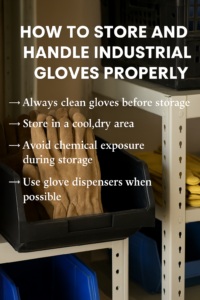Meta Description:
Proper storage and handling of industrial gloves extend their lifespan and ensure workplace safety. Discover essential tips to maintain glove quality and prevent early wear.
Industrial Glove Care: Safe Storage and Handling Tips You Need to Know
In industrial environments, protective gloves play a critical role in safeguarding workers’ hands from cuts, abrasions, chemicals, and extreme temperatures. However, even the highest-quality gloves can become ineffective if not handled and stored correctly. That’s why proper glove care is essential not only for durability but also for safety.
Let’s walk through the best practices for handling and storing industrial gloves the right way.

1. Always Clean Gloves Before Storage
First and foremost, you should clean gloves after each use. If you neglect to do so, residues from chemicals, oil, or dirt can degrade the material. For example, you should brush off leather gloves and wipe them with a damp cloth, whereas you can machine-wash cotton gloves if the manufacturer permits.
Pro Tip: When applicable, manufacturer cleaning guidelines must be followed to avoid damage.
2. Store in a Cool, Dry Area
Once you clean the gloves, allow them to air dry completely. Storing damp gloves can cause mold growth or material breakdown over time. Therefore, store them in a dry, ventilated space. Additionally, keep the gloves away from direct sunlight and heat sources, because extreme conditions can harden rubber or crack leather.
3. Avoid Chemical Exposure During Storage
Once you clean the gloves, allow them to air dry completely. Storing damp gloves can cause mold growth or material breakdown over time. Therefore, store them in a dry, ventilated space. Additionally, keep the gloves away from direct sunlight and heat sources, because extreme conditions can harden rubber or crack leather.
4. Handle with Clean, Dry Hands
Before putting on gloves, ensure your hands are clean and dry. Oils and moisture from skin can degrade the glove’s interior lining, especially if repeated contact occurs.
Also, while removing gloves, it is best to pull them off by the cuff instead of the fingers. This prevents unnecessary stretching or tearing at the fingertips.
5. Inspect Regularly for Wear and Tear
Even when not in frequent use, gloves must be inspected periodically. Cracks, thinning, or hard spots are signs that the material has begun to degrade. Such gloves should be discarded immediately.
In some cases, storage labels or tags can be added to monitor the glove’s age or rotation schedule.
6. Never Mix Used and Unused Gloves
To ensure hygiene and prevent cross-contamination, store used gloves separately from new ones. This is especially important in environments where biological or chemical substances are handled.
By doing so, you reduce the risk of contamination and help preserve the quality of the gloves for as long as possible.
7. Use Glove Dispensers When Possible
In high-traffic industrial zones, glove dispensers make handling more hygienic and organized. By keeping gloves clean, dust-free, and protected from surface contact, dispensers extend the gloves’ lifespan and ensure easy access.
Conclusion
To sum up, industrial gloves are only as effective as the care they receive. Through proper cleaning, careful handling, and correct storage, their protective qualities can be preserved significantly longer. When gloves are stored responsibly, safety is not just maintained it’s enhanced.
By implementing these simple best practices, businesses can reduce glove replacement costs, support worker safety, and contribute to a cleaner, more efficient workplace.
